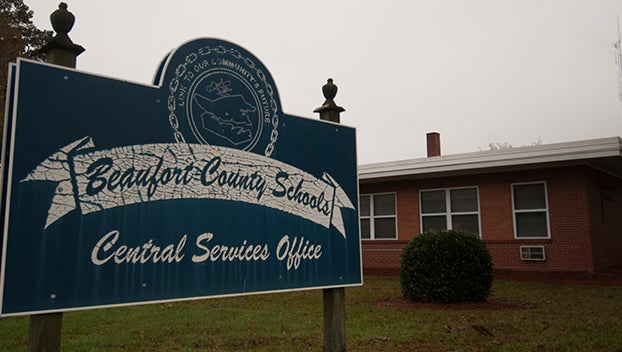‘School is real’ and remote in the age of a pandemic
Published 7:45 pm Friday, November 13, 2020

- AT THE HELM: The school year has brought many challenges, but overall morale is good, as many older students and a small number of teachers are opting to remain remote. (Vail Stewart Rumley/Daily News)
|
Getting your Trinity Audio player ready...
|
A month after students returned to the classroom and/or remote learning, Beaufort County Schools administration, faculty, staff and students are still adjusting to the new look of learning.
“I’m very encouraged. First and foremost, I think our students have done a good job transitioning back, understanding the safety protocols, understanding that we want them to be and do well,” said Matthew Cheeseman, BCS superintendent. “As for our staff, I think they’re just very excited to see the kids again.”
The fall back-to-school is not without its challenges, however, which range from debunking rumors of grades not counting to teachers simultaneously teaching to students in person and online.
BACK TO THE BASICS
Schools, faculty, staff and students had to adjust rapidly in the early days of a global pandemic, switching from in-person to full-time remote learning in a matter of days. Then, the circumstances dictated grading be adjusted, as not every child had access to the devices and internet needed to virtually attend school. Since, Beaufort County Schools, along with nonprofits, civic groups and individuals, have ensured every child has the tools needed to learn remotely.
Though younger grades are back to school in-person four days a week, middle and high school students are separated into two groups that alternate face-to-face and remote learning. All grades are learning remotely on Wednesdays, as schools are closed for cleaning.
The schedule is certainly different from the fall of last year, but accountability is not.
“One thing that we really need help with is making parents and students knowledgeable that school is real, and it counts this year,” Cheeseman said. “I think some families and some students are of the belief that the state is going to wave accountability measures like the state did back in the spring.”
When schools made the quick transition to remote learning in the spring, grading was adjusted by grade levels: Children in grades K-5 received teacher feedback on individual strengths and needs, rather than a grade. Middle-school students received a pass or withdrawal based on performance before March 13, for which students’ improvement during spring remote learning would be taken into account, but students whose performance slipped in that same period would not have it held against their pre-March 13 grades. High-school grading was much the same: based on pre-March 13 grades, plus the option to receive a letter grade or a pass/withdrawal, with a pass/withdrawal not affecting cumulative GPA.
Though those were the options last spring, U.S. Secretary of Education Betsy DeVos sent notice to all states that accountability measures will be in place for the 2020-21 school year.
“School is real; report cards are real; the testing is real,” Cheeseman said.
WHO’S IN SCHOOL
While all learning was remote in the spring, in the fall, high school students were given the option to return on Oct. 15 in two groups, alternating two days in school and two days learning remotely, or continue with remote learning. Though many opted to return to school on the alternating schedule initially, the number of students choosing to attend class from home has been rising.
“More than 50% at the high schools are staying remote. … Especially since the governor has not allowed any class greater than sixth grade to return fulltime, they’re finding that the other two days they’re online anyway, so they’re opting to stay home,” Cheeseman said. “Definitely the 11th- and 12th-grade populations are typically remote learners right now.”
Cheeseman said the choice was likely based on a few factors, unassociated with not enjoying classes and their teachers. Many students have learned they have the ability and skills to do required coursework online, and enjoy more freedom and less restrictions, such as social distancing and mask wearing, that being at home allows them. However, more freshmen and sophomores are opting for face-to-face learning and the social aspect of being in school, if only for two days a week.
“On the flip side, you’ve had some kids come back who may be there for emotional support, especially for kids that may be home alone all day,” Cheeseman said.
WHERE THE TEACHERS ARE
The reimagining of teaching during a global pandemic has been an ongoing challenge. While many teachers are thrilled to be back in the classroom, others have switched jobs within the school system. Some have taken leaves of absence. Another 35 — many of whom have a higher risk for COVID-19 or have high-risk members in their households — have asked for and received accommodation to teach from home full-time.
“In most cases, it’s health-related. We want to make sure we keep them healthy,” Cheeseman said. “At the end of the day, I’m never going to fault someone for wanting to keep themselves safe and healthy. That’s got to be a priority.”
In order to accommodate those accommodations, BCS administration must shift teacher assistants around the county schools to make sure there’s guidance in the classrooms with face-to-face students.
“Some days are a bit of a struggle,” Cheeseman said. “In terms of morale, the kids are uplifting for our adults, but on a day-to-day level, I know they definitely have struggled with it.”
Cheeseman said he places as much of a priority on the mental health of employees as their physical health: “How do you let people know that it’s OK to not be OK? It’s OK not to be OK, but then how can we help you?”
COVID CASES IN THE SCHOOLS
The Beaufort County Schools website has a COVID case tracker, and the numbers are surprisingly low. A total of 20 positive cases across the 14 Beaufort County public schools have been identified. The schools that have had the most positive cases are Eastern Elementary School, John Small Elementary School and Southside High School. There is no differentiation between faculty/staff and students in the numbers, but Eastern Elementary’s back-to-school date was pushed back from Oct. 15 to Oct. 26 due to COVID cases among its staff — BCS did not have enough staff to fill in for those in quarantine.
The North Carolina Department of Health and Human Services guidelines regarding quarantining have changed since March, from 15 minutes of close contact to 15 cumulative minutes, so tracking down the students and/or staff a person testing positive has had contact with has added another complicated task for teachers and administrators.
“Now it’s the cumulative time: how do we look at the contact tracing of it? You have to figure out classroom seating charts, bus charts, lunchtime seating, and that’s another stress to teachers — you have to know where every person is at all times. That’s an additional source of stress,” Cheeseman said.
A GROWING PANDEMIC
Cheeseman sits on the board of the North Carolina School Superintendents’ Association, and with COVID case counts rising nationwide, he says the board is focusing on the future. He said there may be a time when pre-K through fifth graders are in school, and sixth through 12th grades are not, so the emphasis is on having the technology to adjust.
“We need to really make sure that we have a technology plan in place, updating hardware for teachers — it’s strategic planning for the future, because normal is never really going to look the same,” Cheeseman said. “Working with faculty is absolutely critical; the mental welfare of our students, our families and especially our employees — it’s been hard on them. When you disrupt all of that, it’s been hard on all of them.”
While some have been critical of Gov. Roy Cooper’s direction on schools and schooling since the pandemic made its presence known in North Carolina, Cheeseman said at the root of it is human safety. Several votes earlier this year by the Beaufort County Board of Education regarding when and how children should return to school showed the disparity of views on state guidance and the virus as a whole.
“We’re a learning institution. Our core business is learning. We have to follow local, regional, state laws and guidance. Our belief is to keep people safe: what we do is in the best interest of our students and employees,” Cheeseman said. “Anyone can have their opinion whether (the virus) is real or not real, but when we come to the table, we have to work as one unit. People are allowed to believe what they want to believe, but professionally, we’re going to move together and work as one team, and that’s to follow that guidance that’s given to us.”





